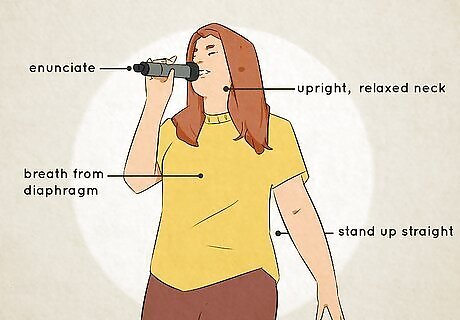
views
- To find your real voice, start by identifying your range. Starting on middle C, sing as far down and then up as you can go along with the piano.
- Then, identify what your chest voice (low notes that resonate in your chest) and head voice (high notes that ring in your head) feel and sound like.
- Choose songs that fit in the most comfortable part of your range (your tessitura). Transpose songs that sit mainly in your extreme low or high notes.
Finding Your Range & Vocal Registers

Find your vocal range. Your vocal range measures the octaves you can sing, from your lowest note to your highest. Find your range by singing scales starting on middle C. Sing downward along with a piano until you reach your lowest possible note and write it down. Then, do the same but going upward from middle C to find your highest note. Use an online or physical keyboard to help find your notes. Some apps, like SingScope, can help you determine your vocal range by identifying the highest and lowest notes you can sing on pitch. Scales are ordered sequences of notes, like do, re, mi, fa, so, la, ti, do. Octaves are musical intervals of 8 notes. For example, do to do or the distance from one note, like C, to the next note of the same name.

Match your vocal range to one of the 7 main voice types. The standard voice types from highest to lowest are soprano, mezzo-soprano, alto, countertenor, tenor, baritone, and bass. Your vocal range may not exactly match the given notes for each voice type, but it should fit generally in one of these ranges. Sopranos sing from middle C to high A or soprano C. This range is musically noted as C4–A5/C6. Mezzo-sopranos sing from the A below middle C to the F above the next C. This range is musically noted as A3–F5. Altos sing from the F below middle C to the second F above middle C. This range is musically noted as F3–F5. Countertenors sing from the G below middle C to the second E above middle C. This range is musically noted as G3–E5. Tenors sing from the C an octave below middle C to the B above middle C. This range is musically noted as C3–B4. Baritones sing from the second G below middle C to the E above middle C. This range is musically noted as G2–E4. Basses sing from the second E below middle C to middle C. This range is musically noted as E2–C4.

Find your tessitura. Your tessitura is the range at which you are the most comfortable and at which your voice sounds the most pleasant. Your vocal range might exceed your tessitura. You might be able to sing very high notes or very low notes, but your tessitura is the range of notes that your voice can produce with more power and ease. What songs do you typically enjoy singing along to? If there are some you love to belt out, it's likely because you can feel that you sound good singing them. Pay attention to the notes in these songs. With training, you may be able to expand the range of notes you can sing with great power.

Find your chest and head voices. When singing scales, your voice will "crack" or break at some point in your natural range. This “break” is the division between your chest and head voice. Chest voice is used when singing in lower notes, and you feel the sound vibrating in your upper chest. Your head voice is the high end of your range that resonates in your head, often considered classical or airy-sounding.

Develop your mixed voice. A mixed voice blends your head and chest voices so you can safely belt or hit higher notes with more power. Use your mixed voice to sing strong notes in spots where your voice typically breaks. To learn what your mixed voice feels like in your body, try this simple exercise: Put your hand on your chest and say “hey” in your speaking voice: that’s your chest voice. Keep your hand on your chest and say “woo” in a high voice like you’re cheering: that’s your head voice. Say “hey” again in a whiny voice, but make sure your pitch is up in your head voice range: that’s your mixed voice. It should feel like a combination of your chest and head voices.

Use good posture and breathing techniques to support your voice. If you have yet to use the right technique, you might not even know what your voice really sounds like. Using the right technique will help your voice sound clear and strong. Keep the following pointers in mind as you practice singing: Have good posture. Stand up straight so you can breathe more easily. Keep your neck upright but relaxed, with your head held straight up. Speaking of breathing, ensure you're breathing from your diaphragm, not your chest. Your stomach should expand when you breathe in and deflate as you breathe out. This technique gives you more control over your pitch. Open the back of your throat and enunciate your vowels when you sing.
Techniques to Practice Singing

Warm up first. Your vocal cords are muscles that need time to warm up so they don't get overstrained. Start by singing scales slowly for about 10 or 15 minutes. You can start singing your practice songs when your vocal cords feel warmed up and ready to go. You can also sing scales and songs on lip trills to help warm up your voice. These exercises help engage your breath support while keeping your vocal cords relaxed.

Pick songs you enjoy that comfortably fit your range. Choosing songs that fall into your voice’s sweet spot or tessitura will give you the best chance of singing well and finding the great singing voice that's been hiding within you for all this time. Sing along with the recordings of the songs you pick until you feel comfortable with the songs. Practice singing the songs without the recording. You can play the instrumental part but don't play the vocals. Try singing songs in a range of genres. You might love hip-hop best, but you could discover you're better at singing jazz or country songs. Give all types of music a chance. If you love a song but can't sing it in the key it was written in, use an app like AnyTune to change the key while maintaining the tempo. Or, use the app to slow down the tempo while learning difficult passages.

Record yourself singing. Use a phone, tablet, computer, or another recording device to record yourself singing after you've warmed up and practiced. Take note of things you need to work on, as well as what sounded good.

Perform for other people. Sing for your family or friends, and ask them for honest reactions to your voice. Performance anxiety can also affect your voice, and you may sound shakier or tenser than you do singing at home. Learn how your voice is affected when performing live and use it to improve your voice in practice. Remember to warm up before performing. Sing in a big, open room with high ceilings if you can; your voice will sound better in that environment than in a low-ceilinged room with carpet. Incorporate constructive feedback into your next practice session. Karaoke clubs are a great place to practice singing in front of others.
Refining Your Voice Over Time

Find the genre and singing style that fits your unique voice. What makes your voice unique? Once you understand the limitations of your range, you can experiment with different singing styles to bring out the best in your voice. Perhaps you have an operatic voice; practice singing classically. Maybe you have a pleasant nasally country twang. Play it up! Even scream-singing and whispering have their place among rock legends. Nothing is off-limits. Taylor Swift Taylor Swift, Singer & Businesswoman Embrace your passion for singing. "I have been singing randomly, obsessively, obnoxiously for as long as I can remember."

Join a band or choir. Singing with other musicians is a great way to get more creative with your vocal style. Sign up for a choir or music club at your church or school, or get together with some friends to start a band where you're the lead vocalist. You could also audition for a musical or start busking in the subway if you're itching to perform.

Take voice lessons. If you're serious about finding your singing voice, getting trained by a professional instructor is the way to go. Voice teachers can teach you how to use your voice as an instrument. You'll probably find that you have a greater range than you thought you did, and your teacher can help you figure out what style fits your abilities. Ask for recommendations from friends or conduct an online search to find voice teachers in your area. Look for voice teachers who sing and teach the genres you're interested in performing. Meet with at least 3 teachers before choosing 1 so you can find the best fit.



















Comments
0 comment